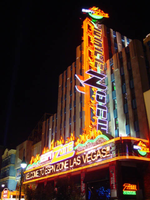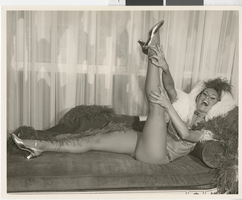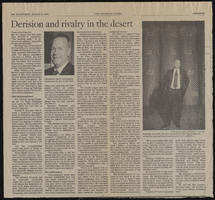Search the Special Collections and Archives Portal
Search Results
Breck Wall Photograph Collection
Identifier
Abstract
The Breck Wall Photograph Collection, approximately 1960 to 1980, consists of black-and-white photographic prints depicting comedian and entertainer, Breck Wall, and other cast members of the comedy revue, “Bottom’s Up!” in Las Vegas, Nevada. Images include scenes from sketches performed on the show, group shots of the cast members off-set, and portraits of Wall.
Archival Collection
Steven Hart Papers
Identifier
Abstract
Papers are comprised of photographs, newspaper clippings, and correspondence dating from the 1950s to the 1980s collected by Steven Hart, son of the Las Vegas, Nevada chef, Nat Hart. The papers include information about Steven Hart's childhood and his service in Vietnam. Also included in the collection are photos of Steven Hart's father, Nat Hart.
Archival Collection

Photographs of ESPN Zone signs, Las Vegas (Nev.), 2002
Date
Archival Collection
Description
Site name: New York-New York Hotel and Casino (Las Vegas, Nev.)
Site address: 3790 S Las Vegas Blvd
Sign details: Located in New York-New York Casino and Hotel
Sign condition: Structure 5 Surface 5 Lighting 5
Sign form: Pylon; Fascia; Porte-cochère
Sign-specific description: The northern end of the property is dominated by the signage for the ESPN Zone sports lounge, located inside the NY NY. The exterior signage is basically a theatre marquee entrance with a long overhang supporting an electronic message banner that reads from left to right. The majority of the theatre front is polished aluminum with thin tubes of red neon above and below the electronic reader board. Above the top edge of the actual front of the sign is a design of pan channels, crafted and shaped to form a complex background for the logo text spelling "ESPN." A wavy green crafted channel creates what looks like a horizon. The space between the marquee and the green channel is a black field laden with incandescent bulbs. Above the green channel an array of pan channels crafted into interlocking, swaying, pointed shapes. They are painted yellow and orange so the result is a bed of flames. These too are lined in the interior of the contour in red and orange neon. In the center of the entire face of the overhand in a black steel cabinet with the logo for the establishment spelling "ESPN Zone." The First portion of the two-word phrase is spelled in shallow channel letters lined with horizontal bars of white neon. The text is outlined in red neon as well. The second half spells "Zone," and is written in the same font with the "Z" being the largest letter in the sign, designed with the bottom horizontal leg underlining the rest of the letters in the word. The word is outlined with white neon as well. The latter portion is filled with horizontal bars of red neon. Situated along the middle of the sign, and against the vertical plane of the building, a blade sign repeats the design and colors of the bottom portion of the sign. The vertical cabinet is double sided spelling the "ESPN Zone" logo vertically with the same neon treatments for the respective words. The three toned background of black, green, red and orange on the bottom of the sign is interpreted on the blade. Running vertically, the black portion laden with bulbs runs against the wall, with the wavy channel next to that, disappearing temporarily behind the letters. The flames hang off of the outer edge of the sign. All of the neon treatments are seen here as well. Crowning the top of the blade sign two circular cabinets are arranged touching each other at one end, the faces pointing out to angled directions. Here the ESPN logo is arranged inside a circle. The bottom half below the letters is filled with horizontal bars of green neon, while the flames are present on the top half. The same cabinets can be seen mounted on the ends of the bottom overhang.
Sign - type of display: Neon; Incandescent; Backlit
Sign - media: Steel; Plastic
Sign - non-neon treatments: Graphics
Sign animation: Notes: The letters in the vertical blade portion of the ESPN Zone illuminate one at a time, starting from the top. Once the entire phrase is lit, in flashes off then on then off, before restating. The orange and red neon tubing which resides inside the pan channels that represent flames flash on and off in a relaxed manner as if to animate the flickering of the flames. The small incandescent bulbs on the black portions above the main matrix reader board flash on and off subtly.
Surveyor: Joshua Cannaday
Survey - date completed: 2002
Sign keywords: Chasing; Flashing; Oscillating; Pylon; Fascia; Porte-cochère; Neon; Incandescent; Backlit; Steel; Plastic; Graphics
Mixed Content

Photograph of Minsky's showgirl posing on a sofa at the Playboy Hotel, Chicago (Ill.), circa 1977
Date
Archival Collection
Description
Image

Photograph of a Minsky's Burlesque showgirl, Playboy Hotel, Chicago (Ill.), circa 1977
Date
Archival Collection
Description
Image

Brendan Ly oral history interview: transcript
Date
Archival Collection
Description
Oral history interview with Brendan Ly conducted by Cecilia Winchell and Stefani Evans on March 27, 2021 for Reflections: The Las Vegas Asian American and Pacific Islander Oral History Project. Brendan discusses his background growing up in communist Vietnam in the early 1970s and fleeing with his family as refugees; they immigrated to Hong Kong, China before moving to the United States to live briefly in North Carolina before settling in California. Brendan talks about working at a young age picking fruit, working in catering, and having positions in retail before pursuing higher education and studying pharmaceuticals. He shares stories of his work experience with Walgreens and how this led to him opening a pharmacy with his brother, which they've managed together for the past 18 years.
Text
Brenda and Johnny Williams oral history interviews
Identifier
Abstract
Oral history interviews with Brenda Manlove Williams and Johnny Williams conducted by Claytee D. White on April 18, 2016 and May 03, 2016 for the African Americans in Las Vegas: a Collaborative Oral History Project. In the first interview, Brenda discusses her early life in Nashville, Tennessee and attending Fisk University. She talks about being a member of The Fisk Jubilee Singers and later transferring to Tennessee State University. Brenda recalls moving to Las Vegas, Nevada in 1972, her employment at Caesars Palace as a cocktail waitress, and the nightlife entertainment at the time. Lastly, Brenda discusses the social and political divides in the African American community of Las Vegas. In the second interview, Johnny describes being one of the first African American card dealers and pit bosses. He talks about his employment at Caesars Palace and changes in the gaming industry. Lastly, Brenda discusses her employment with Regional Transportation Commission of Southern Nevada (RTC).
Archival Collection
Rosemary Tall Dehart oral history interview
Identifier
Abstract
Oral history interview with Rosemary Tall Dehart conducted by Brigid Kelly on November 14, 2002 for the Women's Research Institute of Nevada (WRIN) Las Vegas Women Oral History Project. Dehart opens her interview by discussing her upbringing in Wellingborough, England. She goes on to describe her dance career and receiving an offer to become a member of the Bluebell Girls dance troupe. Dehart talks about performing in Paris, France for shows and movie dance segments. She then discusses traveling from Paris to Las Vegas, Nevada to perform at the Stardust Hotel. Dehart describes the treatment of different types of entertainers and the choreography style of Donn Arden. She then discusses returning to the Stardust later in life to work as a roulette dealer. Dehart ends her interview with a discussion of advice for young dancers and why she chose to settle in Las Vegas.
Archival Collection

